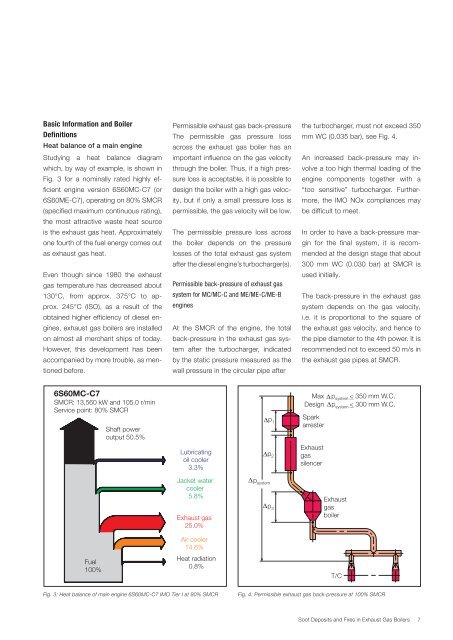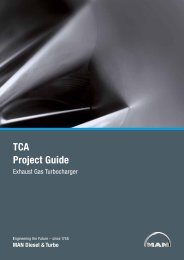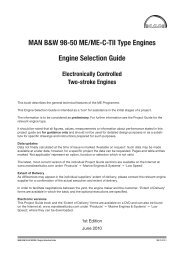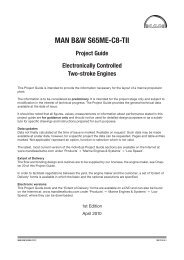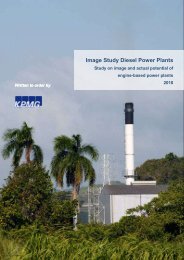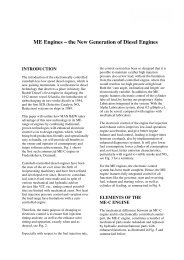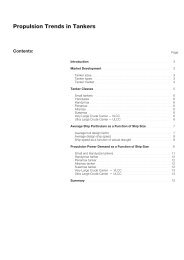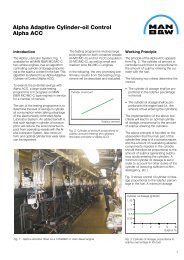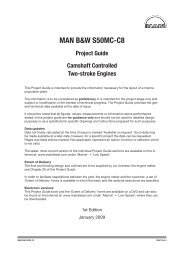Soot Deposits and Fires in Exhaust gas Boilers - MAN Diesel & Turbo
Soot Deposits and Fires in Exhaust gas Boilers - MAN Diesel & Turbo
Soot Deposits and Fires in Exhaust gas Boilers - MAN Diesel & Turbo
Create successful ePaper yourself
Turn your PDF publications into a flip-book with our unique Google optimized e-Paper software.
Basic Information <strong>and</strong> Boiler<br />
Def<strong>in</strong>itions<br />
Heat balance of a ma<strong>in</strong> eng<strong>in</strong>e<br />
Study<strong>in</strong>g a heat balance diagram<br />
which, by way of example, is shown <strong>in</strong><br />
Fig. 3 for a nom<strong>in</strong>ally rated highly ef-<br />
ficient eng<strong>in</strong>e version 6S60MC-C7 (or<br />
6S60ME-C7), operat<strong>in</strong>g on 80% SMCR<br />
(specified maximum cont<strong>in</strong>uous rat<strong>in</strong>g),<br />
the most attractive waste heat source<br />
is the exhaust <strong>gas</strong> heat. Approximately<br />
one fourth of the fuel energy comes out<br />
as exhaust <strong>gas</strong> heat.<br />
Even though s<strong>in</strong>ce 1980 the exhaust<br />
<strong>gas</strong> temperature has decreased about<br />
130°C, from approx. 375°C to ap-<br />
prox. 245°C (ISO), as a result of the<br />
obta<strong>in</strong>ed higher efficiency of diesel en-<br />
g<strong>in</strong>es, exhaust <strong>gas</strong> boilers are <strong>in</strong>stalled<br />
on almost all merchant ships of today.<br />
However, this development has been<br />
accompanied by more trouble, as men-<br />
tioned before.<br />
6S60MC�C7<br />
SMCR: 13,560 kW <strong>and</strong> 105.0 r/m<strong>in</strong><br />
Service po<strong>in</strong>t: 80% SMCR<br />
Fuel<br />
100%<br />
Shaft power<br />
output 50.5%<br />
Permissible exhaust <strong>gas</strong> back-pressure<br />
The permissible <strong>gas</strong> pressure loss<br />
across the exhaust <strong>gas</strong> boiler has an<br />
important <strong>in</strong>fluence on the <strong>gas</strong> velocity<br />
through the boiler. Thus, if a high pres-<br />
sure loss is acceptable, it is possible to<br />
design the boiler with a high <strong>gas</strong> veloc-<br />
ity, but if only a small pressure loss is<br />
permissible, the <strong>gas</strong> velocity will be low.<br />
The permissible pressure loss across<br />
the boiler depends on the pressure<br />
losses of the total exhaust <strong>gas</strong> system<br />
after the diesel eng<strong>in</strong>e’s turbocharger(s).<br />
Permissible back-pressure of exhaust <strong>gas</strong><br />
system for MC/MC-C <strong>and</strong> ME/ME-C/ME-B<br />
eng<strong>in</strong>es<br />
At the SMCR of the eng<strong>in</strong>e, the total<br />
back-pressure <strong>in</strong> the exhaust <strong>gas</strong> sys-<br />
tem after the turbocharger, <strong>in</strong>dicated<br />
by the static pressure measured as the<br />
wall pressure <strong>in</strong> the circular pipe after<br />
Lubricat<strong>in</strong>g<br />
oil cooler<br />
3.3%<br />
Jacket water<br />
cooler<br />
5.8%<br />
<strong>Exhaust</strong> <strong>gas</strong><br />
25.0%<br />
Air cooler<br />
14.6%<br />
Heat radiation<br />
0.8%<br />
∆<br />
∆<br />
∆<br />
∆<br />
the turbocharger, must not exceed 350<br />
mm WC (0.035 bar), see Fig. 4.<br />
An <strong>in</strong>creased back-pressure may <strong>in</strong>-<br />
volve a too high thermal load<strong>in</strong>g of the<br />
eng<strong>in</strong>e components together with a<br />
“too sensitive” turbocharger. Further-<br />
more, the IMO NOx compliances may<br />
be difficult to meet.<br />
In order to have a back-pressure mar-<br />
g<strong>in</strong> for the f<strong>in</strong>al system, it is recom-<br />
mended at the design stage that about<br />
300 mm WC (0.030 bar) at SMCR is<br />
used <strong>in</strong>itially.<br />
The back-pressure <strong>in</strong> the exhaust <strong>gas</strong><br />
system depends on the <strong>gas</strong> velocity,<br />
i.e. it is proportional to the square of<br />
the exhaust <strong>gas</strong> velocity, <strong>and</strong> hence to<br />
the pipe diameter to the 4th power. It is<br />
recommended not to exceed 50 m/s <strong>in</strong><br />
the exhaust <strong>gas</strong> pipes at SMCR.<br />
Max ∆psystem<br />
350 mm W.C.<br />
<<br />
Design ∆p<br />
300 mm W.C.<br />
Spark<br />
arrester<br />
<strong>Exhaust</strong><br />
<strong>gas</strong><br />
silencer<br />
system <<br />
<strong>Exhaust</strong><br />
<strong>gas</strong><br />
boiler<br />
Fig. 3: Heat balance of ma<strong>in</strong> eng<strong>in</strong>e 6S60MC�C7 IMO Tier I at 80% SMCR Fig. 4: Permissible exhaust <strong>gas</strong> back�pressure at 100% SMCR<br />
p system<br />
p 1<br />
p 2<br />
p 3<br />
T/C<br />
<strong>Soot</strong> <strong>Deposits</strong> <strong>and</strong> <strong>Fires</strong> <strong>in</strong> <strong>Exhaust</strong> Gas <strong>Boilers</strong><br />
7


